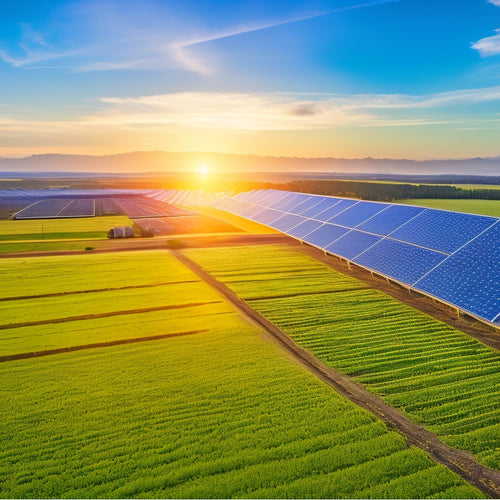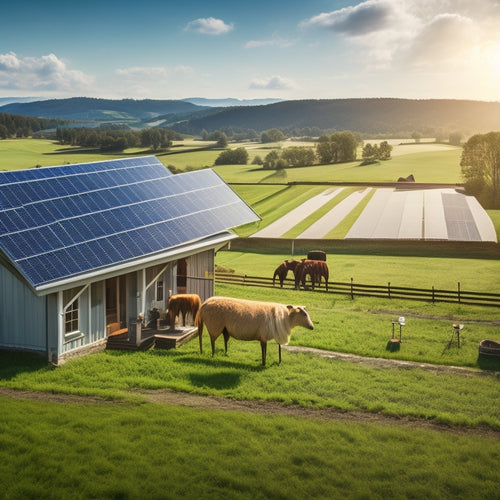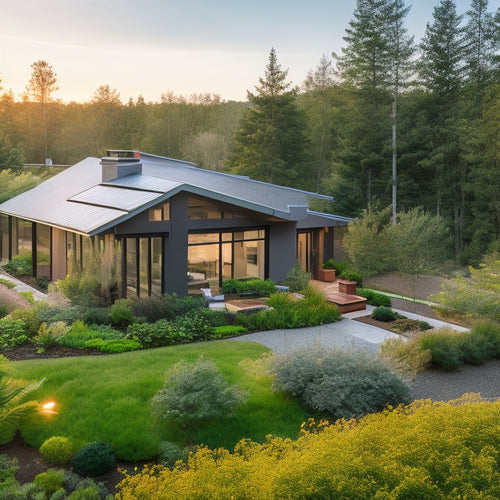
What Is the Solar Panel Set Up Cost for a Homeowner
Share
You can expect to pay between $15,000 to $25,000 for a typical 5-kilowatt solar panel system, with the average installation cost ranging from $2.50 to $3.50 per watt, a considerable drop from the prohibitively high costs of 20 years ago. This upfront investment can be made more manageable with various financing options, including cash purchases, loans, and Power Purchase Agreements. While system size, panel efficiency, and installation complexity affect costs, local incentives and rebates can greatly offset the expense. As you investigate your solar panel setup, you'll want to take into account these factors and more to get a better sense of the total investment required.
Key Takeaways
- The average cost of a 5-kilowatt solar panel system ranges from $15,000 to $25,000, with installation costs between $2.50 to $3.50 per watt.
- System size, panel efficiency, and installation complexity are key factors influencing solar panel costs, with larger systems and higher-efficiency panels being more expensive.
- Roof size, orientation, and complexity can affect installation costs, with south-facing roofs and larger roofs being ideal for solar panels.
- Financing options, local incentives, and rebates can significantly offset the upfront investment, including cash purchases, loans, and Power Purchase Agreements.
- Additional costs for battery backup systems, ranging from $8,000 to $15,000, can provide energy storage and integration with solar components.
Average Cost of Solar Panels
About 20 years ago, the average cost of solar panels was prohibitively high, making them inaccessible to most homeowners.
However, with advancements in technology and economies of scale, the cost of solar panels has considerably decreased. Today, you can consider installing solar panels on your roof, and it's more affordable than you think.
The average cost of solar panels varies depending on your location, roof size, and energy requirements.
On average, a 5-kilowatt solar panel system can cost between $15,000 and $25,000. While this may seem like a considerable upfront investment, you can investigate solar panel financing options to make it more manageable.
Many financing options offer flexible repayment terms, allowing you to spread the cost over several years.
Factors Affecting Solar Panel Cost
Taking into account your decision to invest in solar panels, understanding the factors that affect their cost is vital in making an informed choice. Several variables can influence the overall expense of solar panels, and being aware of them can help you plan your budget effectively.
| Factors | Description | Impact on Cost |
|---|---|---|
| System Size | The number of panels required to meet your energy needs | Higher system size = higher cost |
| Panel Efficiency | The amount of energy produced per hour of sunlight | Higher efficiency = higher cost |
| Installation Location | Roof size, material, and complexity | More complex installation = higher cost |
| Financing Options | Cash purchase, loan, or lease | Financing options can increase or decrease cost |
| Maintenance Costs | Regular cleaning and repair needs | Higher maintenance costs = higher overall cost |
When evaluating solar panel costs, it's important to take into account these factors and how they might affect your overall expenditure. For instance, while higher-efficiency panels may be more expensive upfront, they can lead to long-term savings. Similarly, exploring different financing options can help you find a plan that suits your budget. By understanding these factors, you can make a more informed choice about your solar panel investment.
Cost of Solar Panel Installation
With your solar panel system size and other factors in mind, it's time to examine the cost of solar panel installation. This cost includes the labor and equipment required to install your solar panel system.
On average, the installation cost ranges from $2.50 to $3.50 per watt, depending on the complexity of the installation and the installer's rates. For a typical residential solar panel system, the total installation cost can range from $15,000 to $25,000.
You'll also need to evaluate the installation timeline, which typically takes around 2-5 days for a standard residential installation. However, this timeline can vary depending on the size of your system and the complexity of the installation.
Fortunately, there are various solar financing options available to help you cover the upfront cost of installation. These options include cash purchases, loans, and power purchase agreements (PPAs).
Solar Panel System Size Matters
Your solar panel system size is a critical factor in determining how much electricity you can generate and how much you'll save on your utility bills. A larger system will produce more energy, but it also increases the upfront cost. You'll need to strike a balance between energy production and cost.
To determine the ideal system size, you'll need to evaluate your energy usage, available roof space, and local building codes. A typical residential solar panel system ranges from 3 to 10 kilowatts (kW). A 5 kW system, for example, can generate around 6,000 kilowatt-hours (kWh) of electricity per year, depending on your location and solar panel efficiency. This can translate to significant savings on your utility bills.
When evaluating system size, it's crucial to assess your energy production goals. Do you want to offset a portion of your energy usage or achieve complete energy independence? Your answer will influence the system size you require.
Type of Solar Panels Used
Efficiency is key when it comes to utilizing the sun's energy, and the type of solar panels used plays a significant role in determining your system's overall performance. As you consider your solar panel setup, it's crucial to understand the different types of solar panels available and their varying levels of efficiency.
You'll encounter three primary solar panel types: monocrystalline, polycrystalline, and thin-film. Each type has its strengths and weaknesses, but panel efficiency is a critical factor in determining your system's energy output. Generally, monocrystalline panels are the most efficient, followed by polycrystalline and thin-film panels.
-
Monocrystalline panels boast higher efficiencies (up to 22%) due to their single-crystal silicon structure.
-
Polycrystalline panels have lower efficiencies (up to 18%) but are more affordable.
-
Thin-film panels have the lowest efficiencies (up to 14%) but are flexible and lightweight.
When choosing a solar panel type, you'll need to balance panel efficiency with cost and other factors. Higher-efficiency panels may be more expensive, but they can provide more power per hour of sunlight.
Ultimately, the right solar panel type for you'll depend on your specific energy needs and budget.
Roof Size and Complexity
When you're planning to install solar panels, your roof's size plays a significant role in determining the number of panels you'll need.
A larger roof generally requires more panels, which increases the overall cost of the setup.
Additionally, if your roof has a complex design, such as multiple angles or skylights, it may require specialized installation, adding to the complexity and cost.
Roof Size Matters
Determining the ideal solar panel setup for your home involves evaluating multiple factors, and roof size tops the list. The size of your roof plays a significant role in determining the number of solar panels you can install, which in turn affects the overall energy output. A larger roof allows for more panels, increasing your energy production.
However, it's not just about the size; the complexity of your roof also matters.
-
Roof orientation: A south-facing roof receives the most sunlight, making it ideal for solar panels. East- and west-facing roofs are also suitable, but north-facing roofs may not be as effective.
-
Shading issues: Trees, chimneys, or other obstructions can cast shade on your roof, reducing energy production. You may need to trim trees or consider alternative installation options.
-
Roof shape and design: A simple, rectangular roof is easier to install on than a complex, multi-angled roof.
- Available roof space: Confirm you have enough space for the required number of panels, considering vents, skylights, and other obstructions.
Number of Panels Needed
Calculate the ideal number of solar panels for your home by evaluating your roof's size and complexity. A larger roof with minimal obstructions can accommodate more panels, increasing energy production.
On the other hand, a smaller or more complex roof may require fewer panels. Consider your energy consumption and the solar panel efficiency you need to meet your energy demands.
To determine the number of panels needed, you'll need to assess your roof's available space and your energy requirements. A typical residential solar panel system ranges from 2 to 10 kilowatts (kW), with each kW requiring around 300-400 square feet of roof space.
If you have high energy consumption, you may need a larger system with more panels. Conversely, if you have low energy consumption, a smaller system with fewer panels may suffice.
Complex Roof Design
Your roof's size and complexity play a significant role in determining the ideal solar panel setup for your home. A larger roof typically requires more solar panels, which increases the overall cost of the system. However, the size of your roof isn't the only factor that matters - its complexity can also impact the installation process.
-
A roof with multiple levels, skylights, or unusual angles can create installation challenges, driving up costs.
-
The type of roof materials you have, such as metal, tile, or asphalt shingles, can also affect the installation process and costs.
-
For example, tile roofs may require additional labor and materials to guarantee the solar panels are securely fastened.
- Similarly, metal roofs may require specialized mounting hardware, adding to the overall expense.
These factors can increase the complexity of the installation, leading to higher labor costs and potentially affecting the overall efficiency of the solar panel system.
It's crucial to work with an experienced solar installer who can assess your roof's unique characteristics and design a system that meets your energy needs while minimizing installation challenges.
Local Incentives and Rebates
As you research the cost of solar panels for your home, you'll want to investigate local incentives and rebates that can help offset the upfront investment.
Your utility company may offer special rates or discounts for solar-powered homes, while your state government provides tax credits for renewable energy installations.
Additionally, municipal rebate programs may be available, offering further financial benefits for going solar.
Utility Company Incentives
Local utility companies often sweeten the deal for homeowners investing in solar panels by offering incentives that can greatly reduce the upfront cost.
These incentives can provide significant utility savings and contribute to the long-term benefits of going solar. As a homeowner, you can expect to receive incentives in the form of:
-
Rebates: A one-time payment or credit on your utility bill for installing solar panels.
-
Net Metering: A program that allows you to generate your own electricity and export any excess to the grid, offsetting your energy consumption.
-
Time-of-Use (TOU) Rates: Special rates that charge you less for electricity consumed during off-peak hours, making it more cost-effective to generate your own power.
- Demand Response Programs: Incentives for reducing your energy consumption during peak hours, helping to stabilize the grid and reduce strain on utilities.
State Tax Credits
Thirty-eight states currently offer state tax credits to homeowners who invest in solar panels, providing a considerable reduction in upfront costs.
These credits can be claimed in addition to the federal tax credit, which allows you to deduct a portion of your solar panel system's cost from your federal taxes. When combined, state and federal tax credits can greatly reduce the overall cost of going solar.
You'll need to check with your state government to see if you're eligible for a state tax credit and to learn more about the specific incentives available.
Some states offer a fixed amount per kilowatt-hour of solar energy produced, while others provide a percentage of the total system cost.
You can also investigate solar financing options that allow you to benefit from state tax credits even if you don't have the upfront capital to invest in a solar panel system.
Municipal Rebate Programs
In addition to state and federal incentives, you may be eligible for municipal rebate programs that can further reduce the cost of your solar panel system.
These programs are typically offered by local governments and utilities to encourage the adoption of renewable energy sources.
Municipal rebate programs can provide significant savings, often in the form of a one-time rebate or credit towards the cost of your solar panel system.
To take advantage of these programs, you'll need to check with your local government or utility provider to see what's available in your area.
Some benefits of municipal rebate programs include:
-
Municipal funding: Many cities and counties offer funding for solar installations, which can help offset the upfront cost.
-
Solar grants: You may be eligible for grants from local organizations or non-profits that support renewable energy initiatives.
-
Property tax exemptions: Some municipalities exempt solar panel systems from property taxes, which can save you money in the long run.
- Streamlined permitting: Municipal rebate programs may offer expedited permitting processes, which can save you time and hassle.
Battery Backup System Costs
About $8,000 to $15,000 is what you'll need to budget for a basic battery backup system, which typically includes a 5-10 kilowatt-hour (kWh) battery, an inverter, and a charge controller. This system will provide you with a reliable source of power during outages and allow you to store excess energy generated by your solar panels.
When selecting a battery backup system, you'll need to evaluate the type of battery that best suits your needs. Lead-acid batteries are a popular choice due to their affordability, but lithium-ion batteries offer greater efficiency and a longer lifespan.
System integration is also essential, as it guarantees seamless communication between your solar panel system, battery, and inverter. A well-integrated system will optimize energy storage and reduce waste.
Keep in mind that prices can vary depending on the specific components and features you choose. For example, a system with a larger battery capacity or advanced monitoring capabilities will likely cost more.
Be sure to research and compare different options to find the best fit for your energy needs and budget.
Frequently Asked Questions
Can I Install Solar Panels on a Rented Property?
You can install solar panels on a rented property, but you'll need your landlord's permission. Consider solar leasing options that benefit both you and your landlord, respecting tenant rights and ensuring a mutually beneficial agreement.
How Long Does a Typical Solar Panel Installation Take?
You'll typically spend 2-5 days waiting for permits, 1-3 days on site preparation, and 3-5 days for installation, with the entire project taking around 2-6 weeks, depending on the complexity of your installation timeline and project phases.
Are Solar Panels Covered Under Homeowner's Insurance?
You'll be relieved to know that your solar panels are typically covered under your homeowner's insurance policy, as they're considered a permanent attachment to your home; check your policy coverage to verify it includes solar panel insurance.
Can I Sell Excess Energy Back to the Grid?
You can sell excess energy back to the grid through net metering benefits, which allow you to offset your consumption and receive credits; some utilities also offer energy buyback programs, letting you profit from your excess energy production.
Do Solar Panels Require Regular Maintenance?
You'll be pleased to know that solar panels require minimal maintenance, typically every 6-12 months, to guarantee peak performance, which can extend their lifespan to 25 years or more, giving you a reliable source of power.
Conclusion
As you consider utilizing the power of the sun, it is crucial to understand the costs involved. On average, a solar panel setup can cost between $15,000 and $30,000 for a typical homeowner. Curiously, according to the US Department of Energy, a solar panel system can raise your property value by up to $15,000. With the right installation, you can start saving on energy bills and even enhance your home's value.
Related Posts
-

Solar Power for Reducing Carbon Footprint
Solar power is an effective strategy for reducing your carbon footprint. By adopting solar energy, you can cut greenh...
-

Solar Power Systems for Rural Properties
Solar power systems offer a reliable and efficient energy solution for rural properties, allowing you to gain energy ...
-

Sustainable Home Design for Reduced Carbon Footprint
Sustainable home design is your pathway to a smaller carbon footprint and a healthier living space. By incorporating ...


